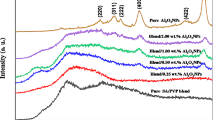Abstract
Nanosized conductive polypyrrole (PPy) powders were prepared using emulsion polymerization with aid of high speed agitation. Different agitation speeds from 650 to 24,000 rpm were used with different anionic, cationic, and non-ionic surfactants. Then, the effects of the agitation speed and surfactant species were examined in terms of their physical and electrical properties of conductivity and powder size. Prepared PPy nanopowders exhibited high conductivity values of 10 S/cm regions, when sodium dodecylbenzenesulfonate (SDBS) and sodium dodecylsulfate (SDS) were used. The powder dispersion of the resultant PPy was also observed to be dependent on the agitation speed and surfactant type. The morphology shown by SEM and TEM revealed that the anionic SDBS surfactant could effectively disperse into nanosized aggregates of the PPy. The results showed that the combination of the anionic surfactants and high agitation in the emulsion polymerization could produce nanosized PPy powders with higher conductivity.











Similar content being viewed by others
References
Tourillion G, Garnier F (1982) New electrochemically generated organic conducting polymers. J Electroanal Chem 135:173–178
Joo J, Lee JK, Lee SY, Jang KS, Oh EJ, Epstein AJ (2000) Physical characterization of electrochemically and chemically synthesized polypyrroles. Macromolecules 33:5131–5136
Romero AJF, Cascales JJL, Otero TF (2005) Perchlorate interchange during the redox process of PPy/PVS films in an acetonitrile medium. A voltammetric and EDX study. J Phys Chem B 109:907–914
Carrasco PM, Grande HJ, Cortazar M, Alberdi JM, Areizaga J, Pomposa JA (2006) Structure-conductivity relationships in chemical polypyrroles of low, medium and high conductivity. Synth Met 156:420–425
Yang C, Liu P (2009) Water-dispersed conductive polypyrroles doped with lignosulfonate and the weak temperature dependence of electrical conductivity. Ind Eng Chem Res 48:9498–9503
Intelmann CM, Syritski V, Tsankov D, Hinrichs K, Rappich J (2008) Ultrathin polypyrrole films on silicon substrates. Electrochim Acta 53:4046–4050
Niside H, Oyaizu K (2008) Toward flexible batteries. Science 319:737–738
Lenz DM, Delamar M, Ferreira C (2003) Application of polypyrrole/TiO2 composite films as corrosion protection of mild steel. J Electroanal Chem 540:35–44
Nguyen MT, Diaz AF (1994) A novel method for the preparation of magnetic nanoparticles in a polypyrrole powder. Adv Mater 6:858–860
Ghanbari K, Bathaie SZ, Mousavi MF (2008) Electrochemically fabricated polypyrrole nanofiber-modified electrode as a new electrochemical DNA biosensor. Biosens Bioelectron 23:1825–1831
Lopez-Crapez E, Livache T, Marchand J, Grenier J (2001) K-ras mutation detection by hybridization to a polypyrrole DNA chip. Clin Chem 47:186–194
Jager EWH, Smela E, Inganäs O (2000) Microfabricating conjugated polymer actuators. Science 290:1540–1545
Wang LX, Li XG, Yang YL (2001) Preparation, properties and applications of polypyrroles. React Funct Polym 47:125–139
Gospodinova N, Mokreva P, Tsanov T, Terlemezyan L (1997) A new route to polyaniline composites. Polymer 38:743–746
Jang J, Oh JH, Stucky GD (2002) Fabrication of ultrafine conducting polymer and graphite nanoparticles. Angew Chem Int Ed 41:4016–4019
DeArmitt C, Armes SP (1993) Colloidal dispersions of surfactant-stabilized polypyrrole particles. Langmuir 9:652–654
Luk SY, Lineton W, Keane M, DeArmitt C, Armes SP (1995) Surface composition of surfactant-stabilised polypyrrole colloids. J Chem Soc Faraday Trans 91:905–910
Stejskal J (2001) Colloidal dispersions of conducting polymers. J Polym Mater 18:225–258
Reung-U-Rai A, Prom-Jun A, Prissanaroon-Ouajai W, Ouajai S (2008) Synthesis of highly conductive polypyrrole nanoparticles via microemulsion polymerization. J Met Mater Miner 18:27–31
Stejskal J, Omastová M, Fedorova S, Prokes J, Trchova M (2003) Polyaniline and polypyrrole prepared in the presence of surfactants: a comparative conductivity study. Polymer 44:1353–1358
Omastová M, Trchová M, Kovářová J, Stejskal J (2003) Synthesis and structural study of polypyrroles prepared in the presence of surfactants. Synth Met 138:447–455
Xing S, Zhao G (2006) Morphology and thermostability of polypyrrole prepared from SDBS aqueous solution. Polym Bull 57:933–943
Zhao H, Gagnon J, Häfeli UO (2007) Process and formulation variables in the preparation of injectable and biodegradable magnetic microspheres. Biomagn Res Technol 5:2
Myers RE (1986) Chemical oxidative polymerization as a synthetic route to electrically conducting polypyrroles. J Electron Mater 15:61–69
Thieblemont JC, Brun A, Marty J, Planche MF, Calo P (1995) Thermal-analysis of polypyrrole oxidation in air. Polymer 36:1605–1610
Berdichevsky Y, Lo YH (2006) Polypyrrole nanowire actuators. Adv Mater 18:122–125
Huang J, Virji S, Weiller BH, Kaner RB (2004) Nanostructured polyaniline sensors. Chem Eur J 10:1314–1319
Crowley K, Cassidy J (2003) In situ resonance Raman spectroelectrochemistry of polypyrrole doped with dodecylbenzenesulfonate. J Electroanal Chem 547:75–82
Jang KS, Lee H, Moon B (2004) Synthesis and characterization of water soluble polypyrrole doped with functional dopants. Synth Met 143:289–294
Author information
Authors and Affiliations
Corresponding author
Rights and permissions
About this article
Cite this article
Hoshina, Y., Zaragoza-Contreras, E.A., Farnood, R. et al. Nanosized polypyrrole affected by surfactant agitation for emulsion polymerization. Polym. Bull. 68, 1689–1705 (2012). https://doi.org/10.1007/s00289-011-0669-7
Received:
Revised:
Accepted:
Published:
Issue Date:
DOI: https://doi.org/10.1007/s00289-011-0669-7




